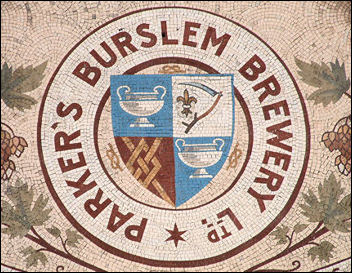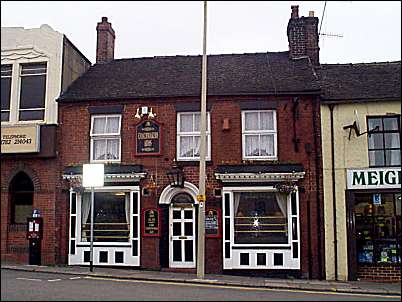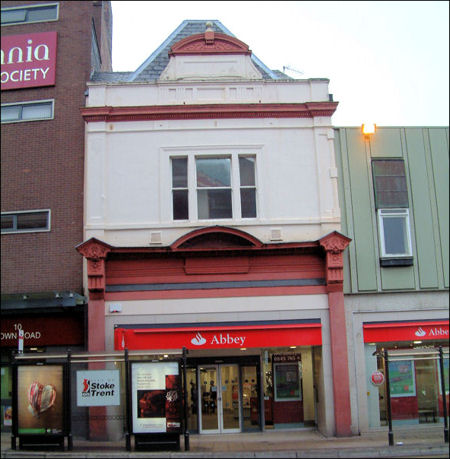|
The Angel, Hanley
 
click the
"contents" button to get back to the main index & map
next: The American, Cobridge
|
Historian Fred Hughes
writes....
Official statistics show that 39 pubs close down every week. Regardless of
the mounting restrictive legislation imposed by the authorities there is
little doubt that our social habits have changed considerably over a
generation. The fact is that pub closures is not a new phenomenon.
|

“One of the biggest local breweries was Parker’s in Burslem"
“Until the 1960’s there was more or less one pub in every terraced
community. In fact some people would be really put out if they had to
walk more than a hundred yards to get a pint at their local,” chuckles
Potteries historian Steve Birks. “One of the biggest local breweries was
Parker’s in Burslem. At its height it had some 600 outlets in North
Staffordshire alone. This is beside the many other regional and national
breweries that also supplied hundreds of pubs in the district, the
biggest of which were Bass Brewery from Burton and Joules from Stone.
It’s fair to say that North Staffordshire didn’t go short on watering
holes. But by the end of the 1960’s most of the town centre communities
had been cleared out as slums, unfit for habitation. Inevitably hundreds
of corner pubs, to use a suitable pun, went for a Burton as well.”

the endangered Coachmakers in Hanley
Pubs, such as the endangered Coachmakers in Hanley, were among dozens
of tiny beer houses that gave succour to claustrophobic communities.
This Hanley district once stretched between Bethesda Street and
Charles Street and contained upwards of 5000 inhabitants served by 15
pubs. It has been completely wiped away and the Coachmakers may soon
be gone too.
“Pubs were our first community centres after church and chapel. They were
built to serve their neighbourhood, which is why we call them ‘locals’,”
explains Steve. “The town centre pubs on the other hand were created to
serve visitors and people out for a good time, a trip to the cinema or a
shopping expedition, not unlike the purpose for which they are still used.
Many of these were demolished in the interest of redevelopment although
some escaped and have been recycled with alternative use. Some buildings
in town centres were protected by preservation legislation. But I cannot
think of any that were saved solely for their primary community use. The
majority simply outlived their purpose in changing and recovering
urbanisation. Nevertheless, if we just took the time to look around us
among all the so-called regeneration strategies, we’d be surprised how
much social heritage is still there. It’s quite impressive how many
buildings there are that were once public houses.”
|
A good example is an edifice most of us pass by everyday yet never
notice its presence. And yet it was one of the most visible and popular
places of pleasure and entertainment right at the heart of the City
Centre overlooking Hanley Market Place – a Mitchell & Butler pub called
the Angel.

The Angel and the Grapes
- the Grapes (Wilders) is being demolished -
“There were two pubs that stood side by side,” continues Steve. “The Angel
was a big posh establishment that wouldn’t have looked out of place in
London or Manchester. Next door stood a much smaller Bass pub named the
Grapes or commonly known as Wilders, I think nicknamed after the licensee.
Both these pubs were demolished nearly thirty years ago, although you can
still see a bit of the frontage of the Angel which these days is occupied
by the Abbey Bank, facing the main entrance to the Potteries Shopping
Centre.”
|

13, Market Street, Hanley
Angel Restaurant & Wine Stores 1893
The Angel was originally built as a grand Victorian restaurant and wine
distributor in the 1890’s with branches throughout the Midlands.
“A company sales bill gives the price of Scotch whisky at 21 shillings per
gallon (£1.10) and best cigars at 42 shillings (£2.20) a dozen,” says
Steve. “In Victorian times the Angel Restaurant was a very popular top
class establishment with superior furnishings and features. The sales bill
boasts of handsome luncheons, dinners, suppers with abundant refreshments
served in first-class style.” |
Plans to reorganise Hanley’s Market Square were however being considered
in the mid 1960’s. And soon many great retail edifices would be gone
forever along with their famous names – Huntbach’s, Swinnertons’,
Sherwin’s, McIlroy’s. By the end of the 1970’s the Angel and the Grapes
were no more, replaced at first by Redman’s butchers and then the new
building of Abbey Bank.

“Yes, just look above the shop front and you can still get a glimpse of
the old Angel,” concludes Steve. “And that’s one of many interesting bits
of forgotten heritage we can catch sight of as we wander around our
exceptional six towns. Social history haunts every corner of the
Potteries. It’s just a matter of knowing where to look for it.”
And that’s what we’ll be doing over the next few weeks, visiting former
boozers that have taken on other identities like the Rose and Crown in
Etruria and the Earl of Clarendon in Longton. Clubhouses in Burslem and
Hanley, a hairdresser’s in Penkhull, a Fenton carpet shop and a pet store
in Longton, all which formerly pulled pints galore. We’ll meet the new
owners and delve into its history. And we’ll discover as well if there are
any spirits still lurking around.
 
click the
"contents" button to get back to the main index & map
next: The American, Cobridge |